Construction Robots Market Size
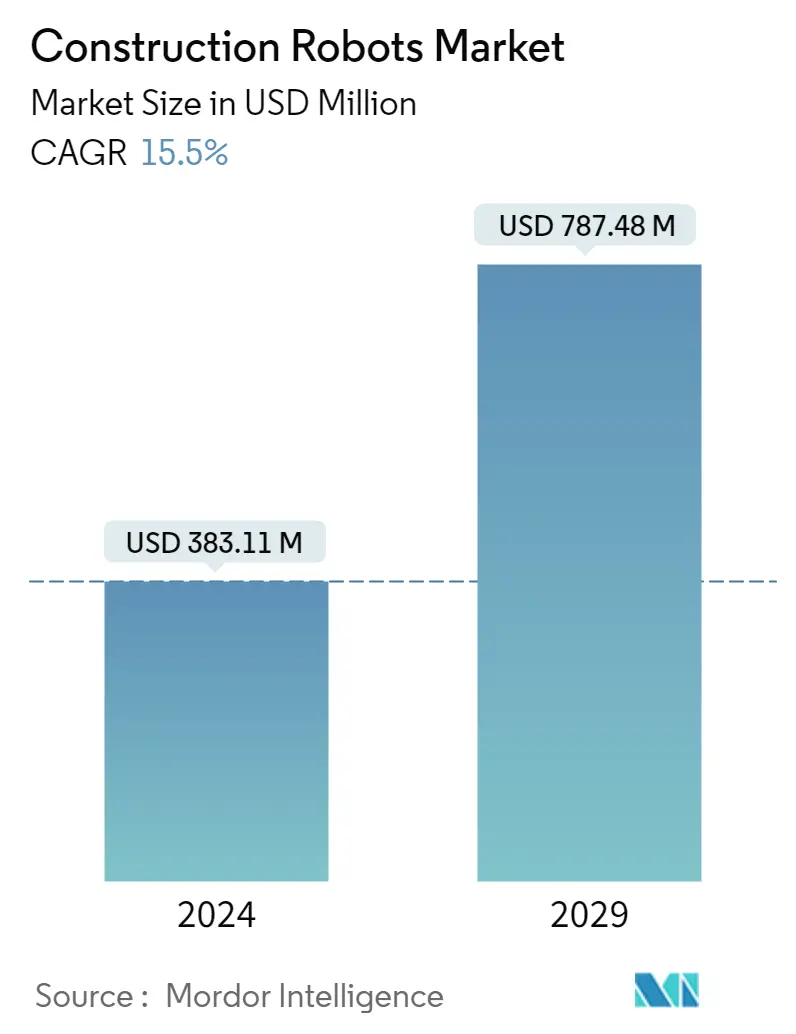
| Study Period | 2019 - 2029 |
| Market Size (2024) | USD 383.11 Million |
| Market Size (2029) | USD 787.48 Million |
| CAGR (2024 - 2029) | 15.50 % |
| Fastest Growing Market | Asia Pacific |
| Largest Market | North America |
Major Players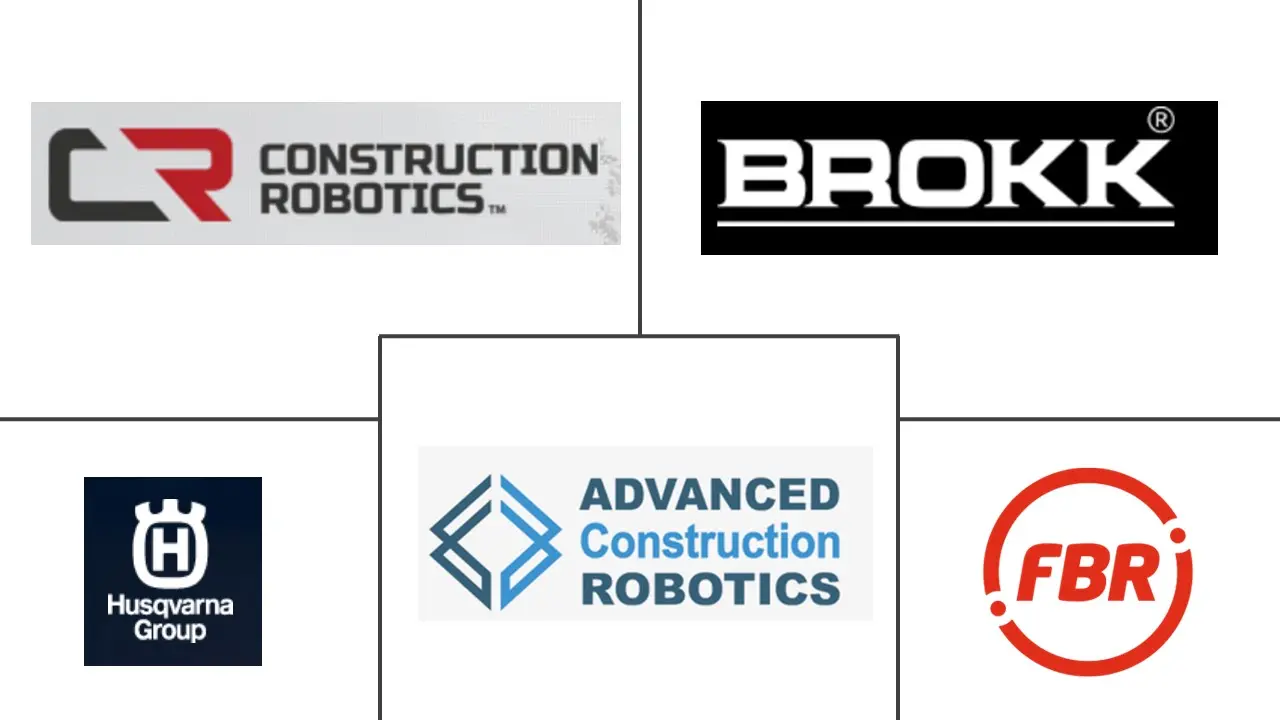
*Disclaimer: Major Players sorted in no particular order |
Need a report that reflects how COVID-19 has impacted this market and its growth?
Construction Robots Market Analysis
The Construction Robots Market size is estimated at USD 383.11 million in 2024, and is expected to reach USD 787.48 million by 2029, growing at a CAGR of 15.5% during the forecast period (2024-2029).
The growing urbanization, industrialization penetration, and advanced construction & demolition operation factors are driving market revenue growth.
- The increasing focus of construction organizations on reducing building materials' resources and material waste during construction will drive the adoption of the construction robot market. Further, Autodesk identifies that while it is difficult to get exact figures of the waste produced on a typical construction site, several construction organizations have thought that nearly 30% of the total weight of building materials transported to a building site gets wasted.
- Further, reducing the construction time of the projects is aiding the growth of construction robots. Printstones, an Austria-based manufacturer of mobile 3D printing robots for construction, has launched its latest manufacturing robot. A modular design indicates the Baubot, which easily allows third-party customer modifications. Described as a 'multi-functional construction robot,' the rover-Esque device goes beyond concrete 3D printing. It qualifies for many flexible manufacturing processes such as material transportation, welding, milling, screwdriver, cutting, painting, and even bricklaying.
- Further, in May 2022, Dusty Robotics raised USD 45 million to announce the Industry's First Hardware, Software, and Services Solution to Destroy Construction Errors Through Advanced Robotics. FieldPrinter automates digital floor techniques on construction sites by printing them full-size on the floor through a mixture of hardware, software, and services.
- With the growing need for new infrastructure, automated construction solutions are expected to gain momentum over the coming years and impact the market positively. According to Redshift, the industry must build 13,000 buildings daily from now to 2050 to support an expected population of seven billion living in urban areas.
- Furthermore, high costs associated with acquiring and maintaining the technologies are one of the challenges in implementing construction robotics. The purchase, along with the implementation of the technologies, is costly. Therefore, only firms with a good turnover and market competition can afford these technologies. In addition to this, automation technologies need to be updated and maintained, and most of them are expensive to do it. The maintenance cost for the new robotics equipment is higher because of the exceptional technician's needs.
- The past outbreak of COVID-19 adversely affected the construction industry, with construction work coming to a standstill in the initial months of the lockdown. However, the product demand witnessed an increased interest in adoption from the industry owing to the safety benefits offered by the technology.
Construction Robots Market Trends
Commercial and Residential Buildings to be the Largest Application for Construction Robots
- With the growing need for new commercial and residential infrastructure, automated construction solutions are expected to gain momentum over the coming years and impact the market positively. According to Redshift, the industry must build 13,000 buildings daily from now to 2050 to support an expected population of seven billion in urban areas.
- Urbanization is rising at an exponential rate. According to World Bank data, about 55% of the world's population, or 4.2 billion people, live in cities, and the trend is expected to continue over the coming years. By 2050, the urban population worldwide is expected to double, with nearly seven out of 10 people living in cities. This is expected to bring about technological changes such as automation and artificial intelligence and rapidly deploy various technologies, including robotics, to address multiple urban challenges.
- According to the World Population Data Sheet 2021, published by the Population Reference Bureau, North America was the most urbanized continent worldwide, with 82% of the population living in cities. In Latin America and the Caribbean, the degree of urbanization stood at 79%. It is projected that the share of people living in urban areas globally will increase from 56% in 2020 to 70% in 2050.
- The need and scale of urbanization are bringing challenges that include meeting accelerated demand for affordable housing, well-connected transport systems, and other basic infrastructure for living. According to the World Bank, nearly one billion urban poor who live in informal settlements are near opportunities that result in conflicts, which is leading to 60% of them being forcibly displaced in urban areas.
- Major economies worldwide are considering building more housing solutions to control the price of homes in urban areas so that lower-income citizens can afford them. Urban planning departments across major economies in North America and Europe are looking to build more housing for the market, which will somewhat moderate some prices. This is where 3D printing solutions that consume significantly less time to build and are sustainable are expected to gain traction in demand over the coming years. The demand for infrastructure and housing solutions in growing economies, mainly situated in the Asia-Pacific region, is expected to accelerate their investment in construction technologies.
- The growing construction of residential places like homes and apartments is expected to propel the demand for construction robots over the forecast period.
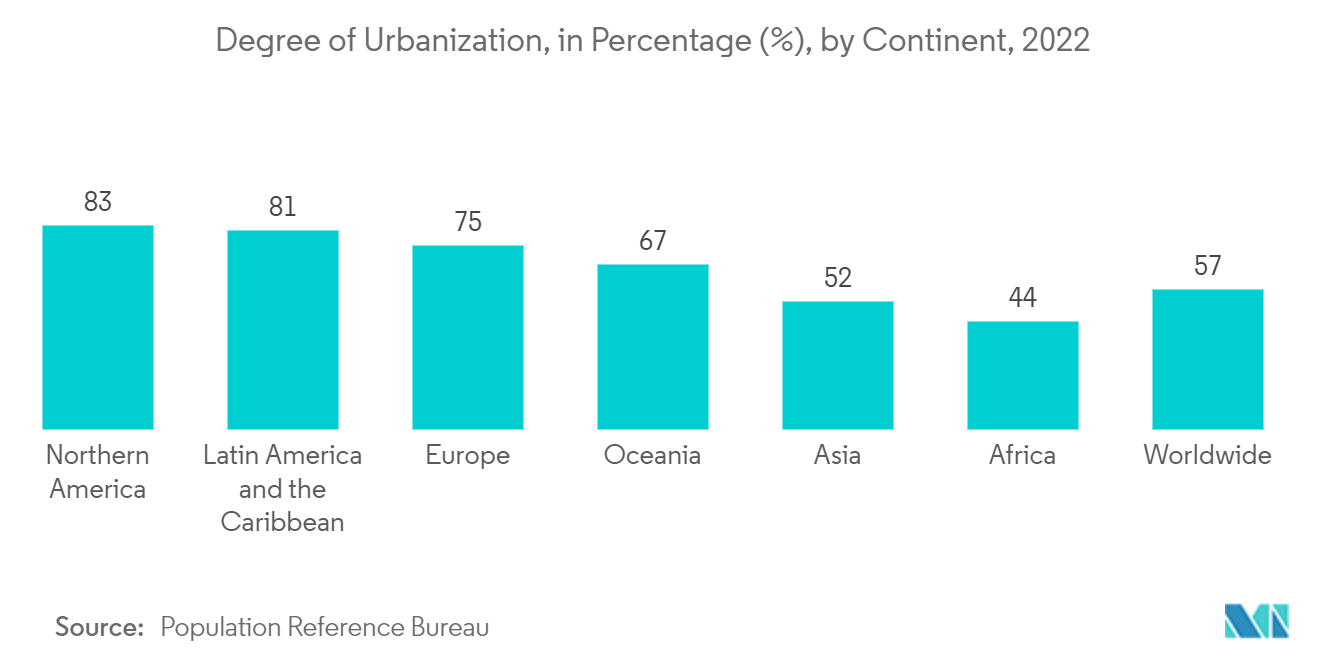
Asia-Pacific to Dominate the Market
- Asia-Pacific is one of the significant regions for the construction robotics market, with the three major countries being India, China, and Japan. The increasing development of 3D-printed houses in the region is expected to boost market growth.
- Additionally, various international companies are looking to expand their regional offerings due to the high demand for 3D printing. For instance, in June 2022, COBOD International, a Danish developer of 3D construction printing technology, signed a new distribution agreement with Fortex, an Australian company, as part of the company's strategy to bring cutting-edge concrete 3D printing technology to Australia and strengthen 3D construction printing in the Asia-Pacific region.
- Asia was already fully embracing robotics and industrial automation before the pandemic. In a post-COVID world, the adoption of these technologies and industries that integrate them, like manufacturing, logistics, and construction, will continue to rise.
- The increasing urbanization is further expected to create demand for market growth. As per the National Bureau of Statistics of China, in 2022, approximately 65.2% of the population in China lived in cities. The urbanization rate has increased significantly in the country over the last few decades.
- The prospect of the construction industry is optimistic, with a strong demand for manpower. Nevertheless, in the face of a continuous and huge amount of construction work, the industry needs to improve construction efficiency and ensure worker and site safety, thereby enhancing overall productivity and cost-effectiveness. Such trends are expected to create positive growth for the market studied over the forecast period.
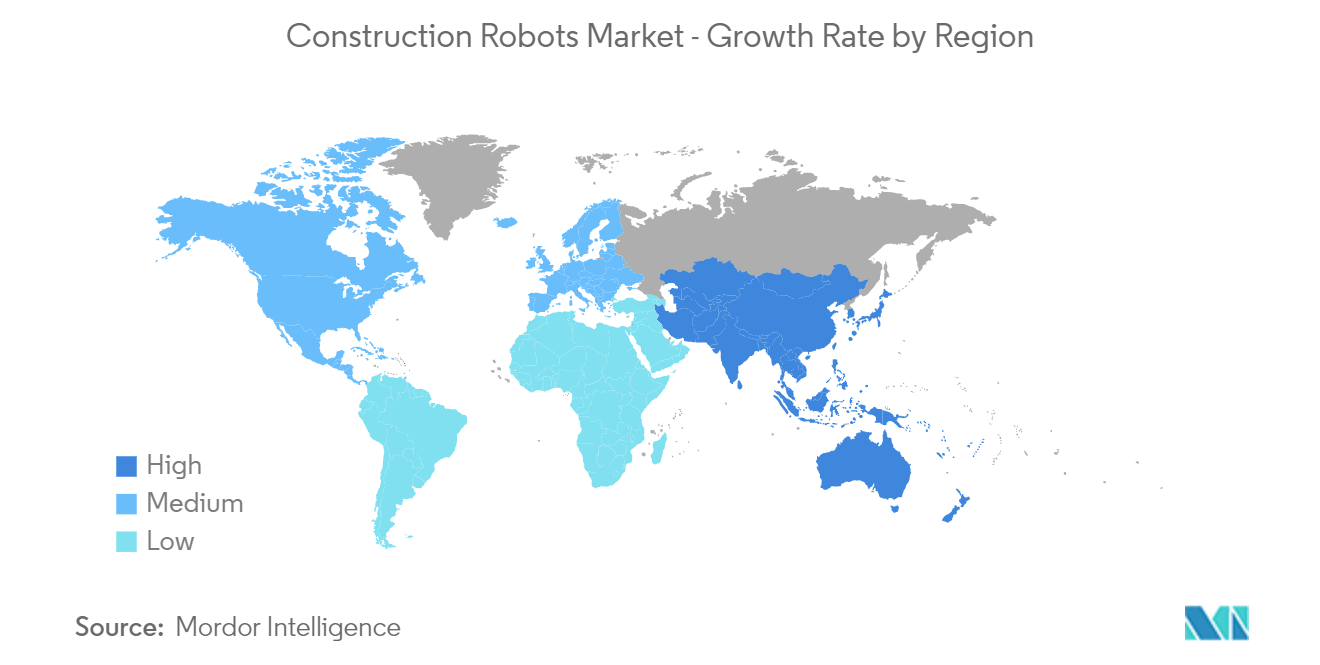
Construction Robots Industry Overview
The construction robots market is fragmented with the presence of major players like Brokk AB (Lifco Public AB), Husqvarna AB, Construction Robotics LLC, FBR Ltd., and Advanced Construction Robotics Inc. Players in the market are adopting strategies such as partnerships, innovations, and acquisitions to enhance their product offerings and gain a sustainable competitive advantage.
In December 2022, Ekso Bionics, an industry leader in exoskeleton technology for medical and industrial use, announced the acquisition of the Human Motion and Control ("HMC") Business Unit from Parker Hannifin Corporation ("Parker"), a global leader in motion and control technologies. The acquisition included the Indegolower limb exoskeleton line of products as well as the planned development of robotic-assisted orthotic and prosthetic devices.
In October 2022, Brokk, the world's leading manufacturer of remote-controlled demolition robots, announced the addition of the BROKK SURFACE GRINDER 530 (BSG 530) attachment for material removal, such as paint and asbestos, surface preparation, and polishing on walls, floors, and ceilings in renovation and restoration applications.
In August 2022, Husqvarna Construction entered into a strategic partnership with AABTools, the region's leading industrial tools and equipment supplier. Husqvarna Construction's organic products were to be distributed by AABTools, including heavy-duty and high-frequency concrete coring machines, wall saws designed for brick and reinforced concrete, remote-controlled demolition robots, and twenty-plus models of handheld power cutters, dust extractors, and floor saws.
Construction Robots Market Leaders
Brokk AB
Husqvarna AB
Construction Robotics, LLC
FBR Ltd
Advanced Construction Robotics Inc.
*Disclaimer: Major Players sorted in no particular order
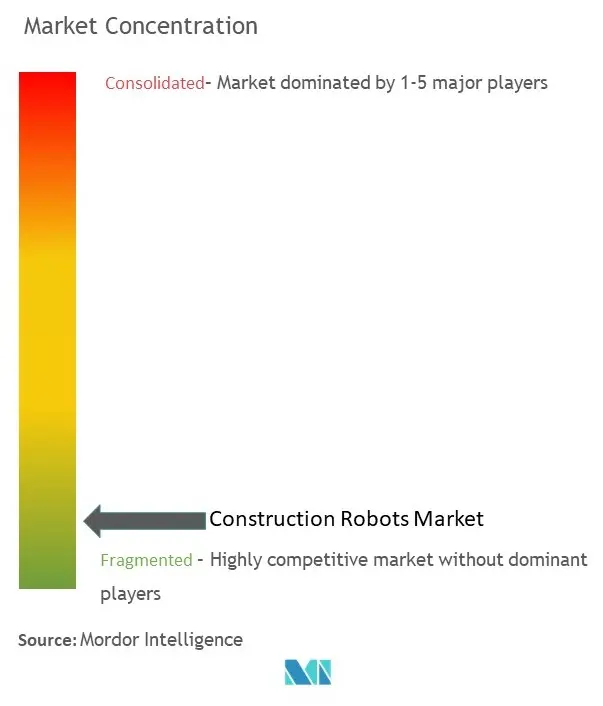
Construction Robots Market News
- March 2023: FBR Ltd. announced a strategic agreement with M&G Investment Management, a UK-based shareholder, to fund the production and deployment of three additional next-generation Hadrian X robots for use in the United States. The three new Hadrian X robots are expected to be built on truck bases in the United States before deployment to provide 'Wall as a Service' bricklaying services through the Perth firm's FastbrickAmericas joint venture.
- March 2023: Advanced Construction Robotics Inc. launched IronBOT, a robot Advanced Construction Robotics (ACR) designed that can lift, carry, and place rebar. The robot, ACR's second product offering, can raise up to 5,000-lb bundles of rebar in a transverse or longitudinal orientation without requiring heavy lifting from crew members. IronBOT can collaborate with ACR's first robot, TyBOT, which can self-tie horizontal rebar intersections. TyBO has an active tie rate of over 1,100 times per hour.
Construction Robots Market Report - Table of Contents
1. INTRODUCTION
1.1 Study Assumptions and Market Definition
1.2 Scope of the Study
2. RESEARCH METHODOLOGY
3. EXECUTIVE SUMMARY
4. MARKET INSIGHTS
4.1 Market Overview
4.2 Industry Attractiveness - Porter's Five Forces Analysis
4.2.1 Bargaining Power of Suppliers
4.2.2 Bargaining Power of Buyers
4.2.3 Threat of New Entrants
4.2.4 Threat of Substitutes
4.2.5 Intensity of Competitive Rivalry
4.3 Impact of COVID-19 on the Market
5. MARKET DYNAMICS
5.1 Market Drivers
5.1.1 Rapid Urbanization
5.1.2 Stringent Government Regulations for Worker's Safety
5.2 Market Restraints
5.2.1 High Equipment and Setup Costs
6. MARKET SEGMENTATION
6.1 By Type
6.1.1 Demolition
6.1.2 Bricklaying
6.1.3 3D Printing
6.1.4 Other Types
6.2 By Application
6.2.1 Public Infrastructure
6.2.2 Commercial and Residential Buildings
6.2.3 Other Applications
6.3 By Geography
6.3.1 North America
6.3.2 Europe
6.3.3 Asia-Pacific
6.3.4 Rest of the World
7. COMPETITIVE LANDSCAPE
7.1 Company Profiles
7.1.1 BROKK AB (Lifco publ AB)
7.1.2 Husqvarna AB
7.1.3 Construction Robotics LLC
7.1.4 FBR Ltd.
7.1.5 Advanced Construction Robotics Inc.
7.1.6 Dusty Robotics
7.1.7 Apis Cor
7.1.8 COBOD International AS
7.1.9 Ekso Bionics
- *List Not Exhaustive
8. INVESTMENT ANALYSIS
9. FUTURE OF THE MARKET
Construction Robots Industry Segmentation
Construction robots are professional service robots that are a part of construction and demolition work in the construction industry. Robots considered part of the study include demolition robots, radiation handling equipment, robots with cutting tools used in the industry, concrete removal robots, hydro demolition, bricklaying robots, 3D printing robots, and exoskeleton and exoskeleton masonry robots. Heavy civil construction robot equipment, such as earthmoving, drilling, and forepoling robots, is separate from the study.
The construction robots market is segmented by type (demolition, bricklaying, and 3D printing), application (public infrastructure, commercial, and residential buildings), and geography (North America, Europe, Asia-Pacific, and the rest of the world). The market sizes and forecasts are in terms of value in USD million for all the segments.
| By Type | |
| Demolition | |
| Bricklaying | |
| 3D Printing | |
| Other Types |
| By Application | |
| Public Infrastructure | |
| Commercial and Residential Buildings | |
| Other Applications |
| By Geography | |
| North America | |
| Europe | |
| Asia-Pacific | |
| Rest of the World |
Construction Robots Market Research FAQs
How big is the Construction Robots Market?
The Construction Robots Market size is expected to reach USD 383.11 million in 2024 and grow at a CAGR of 15.5% to reach USD 787.48 million by 2029.
What is the current Construction Robots Market size?
In 2024, the Construction Robots Market size is expected to reach USD 383.11 million.
Who are the key players in Construction Robots Market?
Brokk AB, Husqvarna AB, Construction Robotics, LLC, FBR Ltd and Advanced Construction Robotics Inc. are the major companies operating in the Construction Robots Market.
Which is the fastest growing region in Construction Robots Market?
Asia Pacific is estimated to grow at the highest CAGR over the forecast period (2024-2029).
Which region has the biggest share in Construction Robots Market?
In 2024, the North America accounts for the largest market share in Construction Robots Market.
What years does this Construction Robots Market cover, and what was the market size in 2023?
In 2023, the Construction Robots Market size was estimated at USD 331.70 million. The report covers the Construction Robots Market historical market size for years: 2019, 2020, 2021, 2022 and 2023. The report also forecasts the Construction Robots Market size for years: 2024, 2025, 2026, 2027, 2028 and 2029.
Construction Robots Industry Report
Statistics for the 2024 Construction Robots market share, size and revenue growth rate, created by Mordor Intelligence™ Industry Reports. Construction Robots analysis includes a market forecast outlook to 2029 and historical overview. Get a sample of this industry analysis as a free report PDF download.
